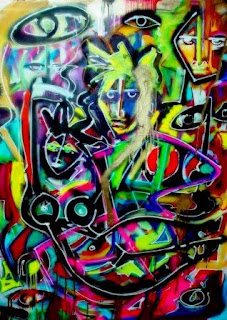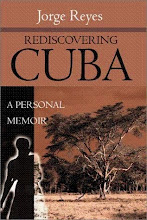The Paintings of David Martinez

by Jorge Reyes
Life
David Martinez (b. 1980- ), a Cuban-born artist, paints the urban landscapes of his native land, Cuba, with its magnificent architectural ruins, symbols of both metaphor and protest, death and regeneration. From an early age, David's inclination for the arts was obvious. At the age six, his first gallery show was presented at the Biblioteca Nacional, Cuba, as part of a collective gallery exhibition of elementary-age children.
A graduate of the prestigious Academy of San Alejandro, citadel to some of the most respected Cuban artists (both past and present) like masters Wilfredo Lam and Amelia Pelaez, and the exiled Gustavo Acosta, among many others. Like them, his paintings reflect a certain essential striving to understand the rich cultural history emblematic in his paintings, while at the same time the images of destruction, rotted wood, and cross-shaped cities erected against the backdrop of the sky incorporates the paradox of religious hope, and desperation.
Works
David Martinez aesthetics is not, ironically, overtly political though his iconography is highly circumspect by the politics from whence it emanates. This is not surprising. In a country that regulates freedom of expresion, often expression is known for its lack of overt political criticism as for its subtle covert symbols, hence the bandages that seem to hold together the buildings Martinez recreates.
Martinez's pieces, especially his earlier works, are a cornucopia of life as is. It is a portrait of a society haunted by its timeless disharmoney from the rest of the world and a portray of a dynamic, personal, and often quiet inner vista into a constantly reinterpreted, often kaleidoscopic, grim realism that upholds as much as it uplifts the surreal, the grotesque, and the marginal. It is not, surprisingly, a portrait of nostalgia though.
Martinez's overall theme seem to mediate between the basic human striving to understand the almost perennial existential despair of being uprooted, exiled, and the subtle ways we express that same sense of displacement. Perhaps political statements, though not necessarily since the mediation between the political and the symbolic merge into a paradigm that, yes, embraces particular forms of repression, political or otherwise) while at the same time it liberates the ego from the context of history beyond the quotidian.
 Surprisingly, the artist says very little about himself, who he is, or what he truly believes. He steps back, contemplates, allowing us to observe the eeriness of an empty sea enclosed by bandaged-like crumbling buildings, androgynous-like females in a quiet, meditative moment of masturbation, like in El Tiempo de los Amantes.
Surprisingly, the artist says very little about himself, who he is, or what he truly believes. He steps back, contemplates, allowing us to observe the eeriness of an empty sea enclosed by bandaged-like crumbling buildings, androgynous-like females in a quiet, meditative moment of masturbation, like in El Tiempo de los Amantes.
In this particular painting, unusual in Martinez's oeuvre by both subject matter and symbolism, the fine line between the enclosing of self-space is pointedly underscored by our own complicity watching two females lying at different ends of a sofa, (close enough to each other though not too close to fully enjoy themselves), and by the guilt that it causes by both voyeur and performers.
 No less eerie and is another unusual painting which somehow falls outside the context of his other paintings, El gallo y yo, an unsettling painting. Again, the painting depicts another androgynous-looking, middle-aged woman with dark unkempt hair dressed no less than in what looks like military garb from another century. She holds in her hand like a priced collection the neck of dead rooster.
No less eerie and is another unusual painting which somehow falls outside the context of his other paintings, El gallo y yo, an unsettling painting. Again, the painting depicts another androgynous-looking, middle-aged woman with dark unkempt hair dressed no less than in what looks like military garb from another century. She holds in her hand like a priced collection the neck of dead rooster.
Her outfit, the symbolism of the dead rooster, and the entire belle epoque surreal setting gives this painting an enigmatic, almost awkward discomfort. After all, what is the significance of the rooster? why is she dressed in something which seems, at best, out of place? could the rooster be nothing more than a statement of economic problems of present-day Cuba? the struggle, almost pedestrian subsistence of Castro's Cuba? I doubt it. Who is she, after all? Bored as she may seem, she's out of place and she doesn't care. The habitual has overtaken the identity of the individual to the culture to the extent that she could very well be naked and still be holding the rooster, and still have the same look of resignation and boredom as she expressed in this painting.
Artists from any generation have sought to understand their times in similar fashion as David Martinez has tried to do in such short and prolific artistic career.
The problem is that the past is, at best, illusory and often deceptive, particularly to the young; and the present of course does not lend itself to answers, especially under a dictatorship. Hence, the very reason that the paintings often produced under these circumstances become a reverberation of a-temporality, enigmatic self-expression of an overarching horizon laden with ambiguity, anger, or subtleties. How this is expressed in art often varies, though not radically different. After all, the enigma becomes manifested thematically by the repetition of seemingly dissimilar symbols, like spiraling multi-dimensional buildings aesthetically being held together by an almost easily pliable string, easily breakable, or reflections of light that seem to swirl in dream-like sequence like a kaleidoscope, like Luces (above), what I consider to be his masterpiece thus far.
In the end, what is being translated into the language of art are variants of the same enigmathe problem of the Idea as one and otherness, individual and collective, or whats more important, the self and the political. Interestingly enough, in what seems the representational understanding of artists trying to understand the present, Martinez seems to have done exactly like most painters in Cuba's past have done: forge an artistic category based exclusively to a continuing evolution of what it means to have Cuban identity. But to name two, Lam and Pelaez. There are others for sure, and there will continue to be many more.
No doubt, David Martinez has already recreated in his canvases a nuanced understanding and sensibility of an emerging and evolving art-form, the result of artists influencing each other both from inside Cuba and those in exile or living abroad.
This is not so different from a rich history of art in Cuba, especially one that began around the 1930's and culminated in the late 1950's. These were a group of painters known as la vanguardia, and their European influence of surrealism had an overt application to Cuba's. To these, it was the poor rural that created that intrinsically affinity to the Cuban identity. And what a wonderfully diverse collection they left us!
Perhaps in the future, David Martinez's paintings may shift to other areas of interest, though the parameters of his own personal style has already been defined.























